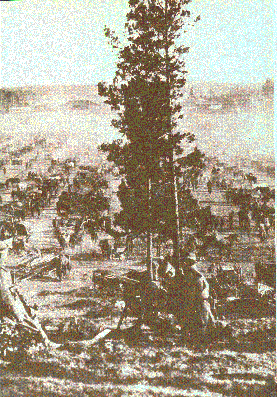


The opinions in the headquarters were more and more inclined towards quick proceedings to avoid increase in the number of prisoners. To speed up the process, the Commander-in-Chief proposed the establishment of field courts martial to the Senate. The general idea was that the worst criminals were to be tried in field courts martial and the big crowds allowed to leave for home. Mannerheim was "inclined to release those red prisoners who were given good recommendations from their home regions, and particularly those who could be considered to have been forced to take part in the uprising". This proposal had practical grounds too. The troops were needed on the front, and there were not enough men available to guard the prisoners. On the other hand, Mannerheim was already thinking of Finland’s ability to unite: the best strategic frontier of a state lies in its unity. He emphasized the importance of building a bridge between the different sections of the post-war nation.
Mannerheim managed to persuade Karl Söderholm, the highest judicial dignitary of white Finland, the president of Vaasa Court of Appeal, to his idea of setting up field courts martial by interpreting military criminal law and regarding the country as being in a state of war. The lawyer members of the Vaasa government, however, took a different viewpoint. In regard to the legislation in force, these field courts martial could not be set up. War against Russia could not have been declared, as the parliament had not been assembled, and the law did not know of such a thing as a state of war during a civil war.
The starting point of the Vaasa Senate was the principle that the rebels were to be tried and convicted on the basis of the general criminal law, and, in case of political crime, in Courts of Appeal. For practical reasons, owing to the large number of prisoners, a decision was reached, however, to establish special Political Offence Courts. Judging the red prisoners was, as regards the whole of the nation, such an important procedure that it should take place in accordance with legislation in as normal court proceedings as possible. The Senate was afraid, and not without reason, that the pressing conditions would lead to illegal executions, if the trials were not organized rapidly. The so-called white terrorism had already begun.
As the police authorities of the headquarters proposed rapid trials Mannerheim said, "Enough blood has been shed. I do not want Finland to be called an executioner." The security chief of the occupied areas, Walden, put forward a proposition to the government on 8 May that field courts martial be set up and prisoners set free, but the government held to the view of investigations and sentences strictly according to the law. The law on Political Offence Courts was ratified in late May. The grounds for punishment were the regulations concerning treason in the criminal law, and in cases of leaders those concerning high treason.
After the red armies had surrendered at the turn of April and May, the reds were gathered into prison camps guarded by soldiers, the biggest of which were Hämeenlinna, Viipuri, Helsinki, Tampere, Riihimäki, Kotka and Lahti. Later on the prison camp in Tammisaari became the best-known. At the end of the war the whites had over 80,000 prisoners. A number of them were released immediately, so that in early June there were 74,000 prisoners left. In late summer the number decreased rapidly, being 71,000 on 1 July, 41,000 on 1 August and 27,000 on 1 September. The Senate adopted the line of action that all the reds were to be tried in legal courts to punishments decreed by the law. The prolonged investigation process, however, led to a situation, where many reds fell victim of malnutrition and diseases due to the bad conditions of the prison camps. By the spring of 1919, as many as 12,500 reds had died in prison camps.
Commander-in-Chief 1918 | Headquarters 1918
| Vaasa Senate | Hannes Ignatius
| Martin Wetzer | Harald Hjalmarson
| Ernst Linder | Gösta Theslöf | Jägers | St Petersburg Question | Relations with Germany | Cross of Liberty
| Eastern Karelia | Uusimaa Dragoon
Regiment | Fir Twig | Finnish Flag
| Swedish Brigade | Civil Guards | Jäger Conflict | Heikki Kekoni | Red Prisoners | Wilhelm Thesleff
| Aarne Sihvo | Rudolf Walden |
Air Force - Air Weapon | Red and White
Terrorism | Great Parade 16 May, 1918 | Åland Question | Monarchy | Mannerheim's Resignation
COURSE OF LIFE | FAMILY | TIME OF GROWTH | MILITARY CAREER | WAR OF INDEPENDENCE | REGENT 1918-1919 | CIVILIAN | DEFENCE COUNCIL | COMMANDER-IN-CHIEF 1939-1946 | PRESIDENT OF THE REPUBLIC 1944-1946 | RETIREMENT | SPECIAL TOPICS | SEARCH